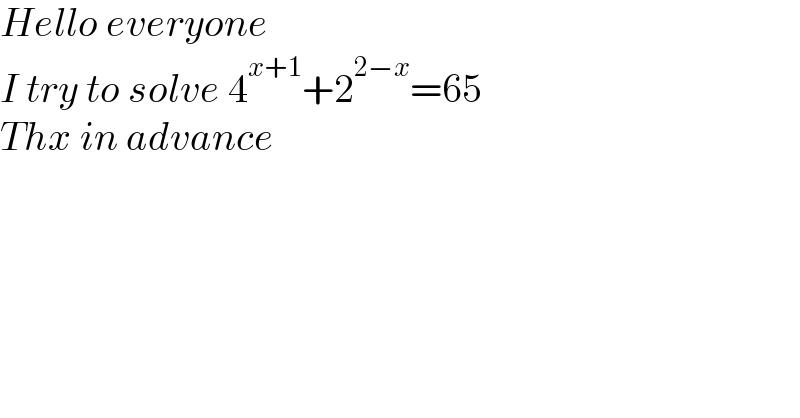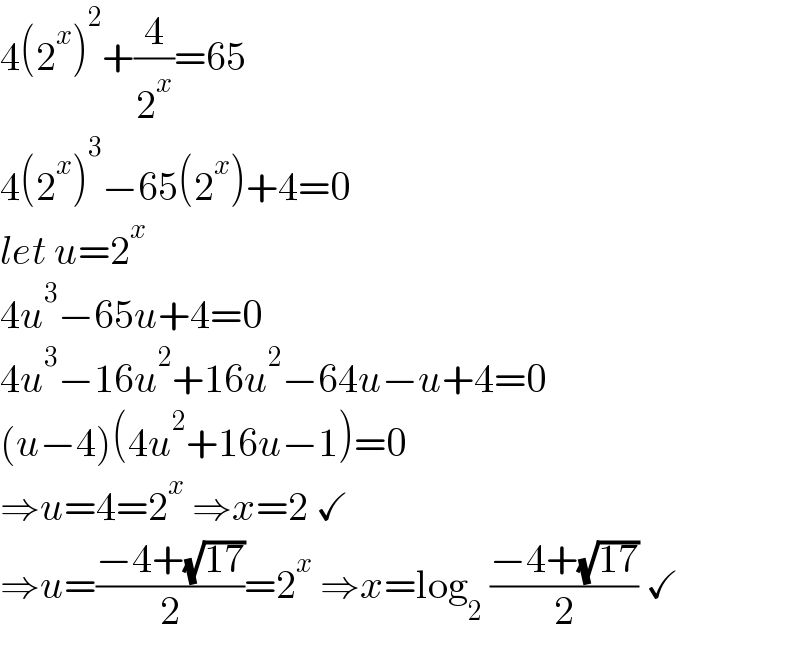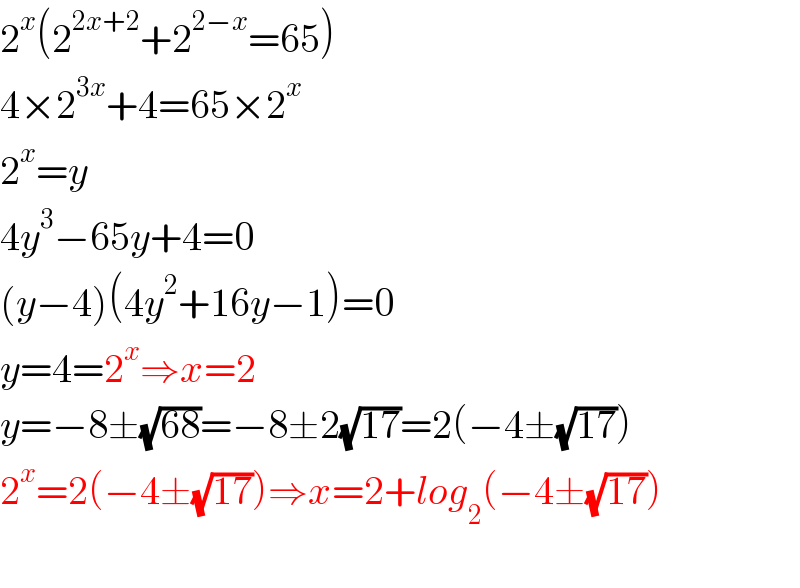
Question Number 194176 by Skabetix last updated on 29/Jun/23

$${Hello}\:{everyone} \\ $$$${I}\:{try}\:{to}\:{solve}\:\mathrm{4}^{{x}+\mathrm{1}} +\mathrm{2}^{\mathrm{2}−{x}} =\mathrm{65} \\ $$$${Thx}\:{in}\:{advance} \\ $$
Answered by Skabetix last updated on 29/Jun/23

$${I}\:{found}\:{x}=\mathrm{2}\:{but}\:{there}\:{is}\:{an}\:{other}\:{solution} \\ $$
Answered by mr W last updated on 29/Jun/23

$$\mathrm{4}\left(\mathrm{2}^{{x}} \right)^{\mathrm{2}} +\frac{\mathrm{4}}{\mathrm{2}^{{x}} }=\mathrm{65} \\ $$$$\mathrm{4}\left(\mathrm{2}^{{x}} \right)^{\mathrm{3}} −\mathrm{65}\left(\mathrm{2}^{{x}} \right)+\mathrm{4}=\mathrm{0} \\ $$$${let}\:{u}=\mathrm{2}^{{x}} \\ $$$$\mathrm{4}{u}^{\mathrm{3}} −\mathrm{65}{u}+\mathrm{4}=\mathrm{0} \\ $$$$\mathrm{4}{u}^{\mathrm{3}} −\mathrm{16}{u}^{\mathrm{2}} +\mathrm{16}{u}^{\mathrm{2}} −\mathrm{64}{u}−{u}+\mathrm{4}=\mathrm{0} \\ $$$$\left({u}−\mathrm{4}\right)\left(\mathrm{4}{u}^{\mathrm{2}} +\mathrm{16}{u}−\mathrm{1}\right)=\mathrm{0} \\ $$$$\Rightarrow{u}=\mathrm{4}=\mathrm{2}^{{x}} \:\Rightarrow{x}=\mathrm{2}\:\checkmark \\ $$$$\Rightarrow{u}=\frac{−\mathrm{4}+\sqrt{\mathrm{17}}}{\mathrm{2}}=\mathrm{2}^{{x}} \:\Rightarrow{x}=\mathrm{log}_{\mathrm{2}} \:\frac{−\mathrm{4}+\sqrt{\mathrm{17}}}{\mathrm{2}}\:\checkmark \\ $$
Answered by MM42 last updated on 29/Jun/23

$$\mathrm{2}^{{x}} \left(\mathrm{2}^{\mathrm{2}{x}+\mathrm{2}} +\mathrm{2}^{\mathrm{2}−{x}} =\mathrm{65}\right) \\ $$$$\mathrm{4}×\mathrm{2}^{\mathrm{3}{x}} +\mathrm{4}=\mathrm{65}×\mathrm{2}^{{x}} \\ $$$$\mathrm{2}^{{x}} ={y} \\ $$$$\mathrm{4}{y}^{\mathrm{3}} −\mathrm{65}{y}+\mathrm{4}=\mathrm{0} \\ $$$$\left({y}−\mathrm{4}\right)\left(\mathrm{4}{y}^{\mathrm{2}} +\mathrm{16}{y}−\mathrm{1}\right)=\mathrm{0} \\ $$$${y}=\mathrm{4}=\mathrm{2}^{{x}} \Rightarrow{x}=\mathrm{2} \\ $$$${y}=−\mathrm{8}\pm\sqrt{\mathrm{68}}=−\mathrm{8}\pm\mathrm{2}\sqrt{\mathrm{17}}=\mathrm{2}\left(−\mathrm{4}\pm\sqrt{\mathrm{17}}\right) \\ $$$$\mathrm{2}^{{x}} =\mathrm{2}\left(−\mathrm{4}\pm\sqrt{\mathrm{17}}\right)\Rightarrow{x}=\mathrm{2}+{log}_{\mathrm{2}} \left(−\mathrm{4}\pm\sqrt{\mathrm{17}}\right) \\ $$$$ \\ $$
